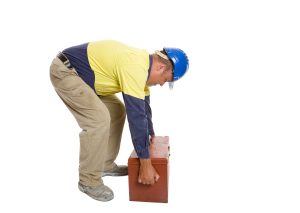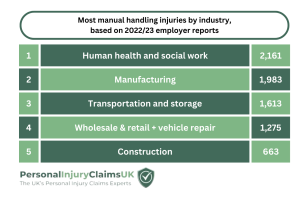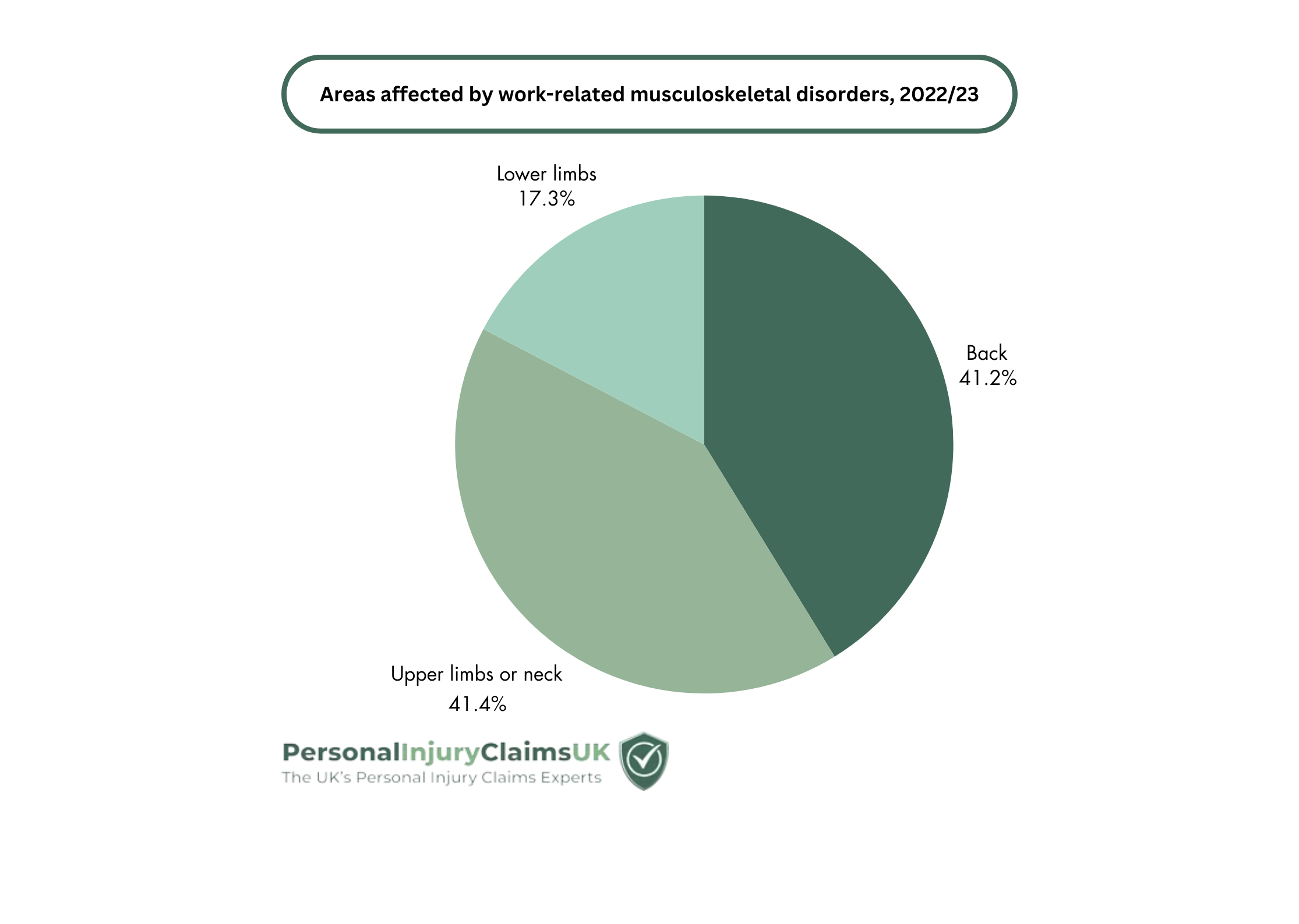This guide tells you what percentage of workplace injuries are caused by manual handling accidents. Manual handling is the transportation of a load using bodily force, done by either putting down and lifting, pushing, carrying, moving, or pulling. Manual handling operations can be dangerous, and if the correct safety procedures are not followed, then an employee could suffer minor to serious injuries.
We look at what percentage of workplace injuries are caused by manual handling compared to other types of workplace incidents. Following this, we then look at what industries have a higher risk of manual handling accidents and, thus, who might be more at risk of suffering a manual handling injury.
Furthermore, this guide discusses some common manual handling injuries and provides statistics on specific types of work-related musculoskeletal disorders.
We also explain what risks an employer needs to consider when asking an employee to perform manual handling activities in order to prevent, as much as they possibly can, an accident from happening.
To see how we could help you if you have suffered a manual handling injury at work, you can contact a member of our advisory team via one of the following methods:
- Call on 020 8050 2736
- Contact us online.
- Ask a question using the live chat pop-up.
Jump To A Section
- What Percentage of Workplace Injuries Are Caused By Manual Handling?
- What Industries Have A Higher Risk Of Manual Handling Accidents?
- Statistics About Musculoskeletal Disorders
- How Could Manual Handling Accidents Be Prevented?
- How We Could Help If You Have Suffered A Manual Handling Injury
- Useful Resources About Manual Handling Injuries
What Percentage of Workplace Injuries Are Caused By Manual Handling?
The Health and Safety Executive (HSE) is Britain’s regulatory body for workplace health and safety. Employers must report certain workplace incidents to the HSE under the Reporting of Injuries, Diseases, and Dangerous Occurrences Regulations 2013 (RIDDOR).
There are annual reports released by the HSE about how many work-related non-fatal injuries were reported under RIDDOR in the UK. For the year 2022/23, a total of 60,645 non-fatal injuries were reported by employers under RIDDOR. Out of these reports, the most common types of accidents reported were:
- Slips, trips or falls on the same level – 19,202.
- Handling, carrying or lifting – 10,230.
- Struck by a moving, including falling/flying, object – 6,428
- Falls from a height – 5,118
- Acts of violence – 5,065.
Roughly 17% of these injuries were due to handling, carrying or lifting (manual handling) accidents. This makes manual handling the 2nd highest cause of non-fatal injuries at work.
How Could You Suffer A Manual Handling Injury
Some examples of how an employee could sustain a non-fatal workplace injury from a manual handling accident include:
- They use an incorrect lifting technique when lifting heavy equipment on a construction site because they received no manual handling training on how to complete this appropriately and safely.
- The load that the employer has asked an employee to lift is too heavy for just one person. Despite raising their concerns over the weight of the load, their employer still makes them carry it on their own. When the employee tries to lift the object, they drop it on their foot.
- An employee is using a platform hand truck trolley to push heavy loads. However, this equipment is broken, causing the heavy load to fall on top of the employee.
If you have suffered an injury due to receiving no manual handling training, you can contact our advisors to see how we may be able to help you. You can also continue reading this guide to learn more about what percentage of workplace injuries are caused by manual handling.
What Industries Have A Higher Risk Of Manual Handling Accidents?
Out of the 10,230 non-fatal injuries at work in 2022/23 that were caused by handling, carrying, or lifting, the most common industries that these manual handling incidents occurred in were:
Types Of Injuries That Could Be Caused By Manual Handling Accidents
Some common manual handling injuries that could result from an accident at work include:
- Back injuries.
- Muscle tears.
- Sprains and strains.
- Neck injuries.
- Arm injuries, such as upper limb disorders.
- Foot injuries.
- Shoulder injuries, such as dislocations.
- Musculoskeletal disorders
If you have suffered any of these injuries in a manual handling accident at work, you can contact one of our advisors to see how we may be able to help you.
Statistics About Musculoskeletal Disorders
Musculoskeletal conditions affect bones, joints, muscles, and nerves. Musculoskeletal disorders have the potential to cause long-term effects.
The HSE reports that 473,000 workers suffered from a new or long-standing work-related musculoskeletal disorder in 2022/23.
For all of these work-related musculoskeletal disorders that were suffered in 2022/23, these areas were affected:
How Could Manual Handling Accidents Be Prevented?
Before assigning any manual handling tasks, there are certain risk factors that an employer should consider. Firstly, if the task can be avoided, it should. Manual handling operations can be avoided by mechanising or automating the process, or the task should be redesigned to avoid moving the load.
Any manual handling tasks that cannot be avoided should be risk assessed. Some of the factors that should be taken into consideration when this risk assessment is taking place are:
- The size and weight of the object.
- The conditions of the work environment. If, for example, the workplace is cluttered with a lot of obstacles in the way, this will make the task harder to perform.
- The frequency of the task.
- The postures adopted by employees.
As well as assessing the above risk factors, some things an employer could do to reduce the risk of injury include:
- Breaking up larger consignments into smaller loads.
- Ensuring that appropriate training has been provided to the person performing the manual handling task.
- Modifying the workplace to reduce twisting movements and carrying distances.
- Make loads easier to grasp, lighter and smaller.
In the next section, we discuss how we could help if you have suffered a manual handling injury at work. Alternatively, you can contact one of our advisors.
How We Could Help If You Have Suffered A Manual Handling Injury
Now that we have discussed what percentage of workplace injuries are caused by manual handling, you may be wondering what you could do if you have suffered such an injury.
If you have been involved in a manual handling accident at work, you may be able to claim compensation for the injuries you have suffered. However, you will need to prove the following apply to your case:
- Your employer owed you a duty of care.
- They breached their duty.
- You suffered manual handling injuries as a result of this breach.
While in the workplace, your employer must take reasonable steps to reduce the risk of you suffering an injury. This is their duty of care, as outlined within the Health and Safety at Work etc. Act 1974. If they breach this duty, and you are injured as a result, you could be eligible to make a personal injury claim.
You can contact our advisors to see whether you may have a valid claim. If you do, they could connect you with a solicitor on our panel. Furthermore, they may then offer to represent your case on a No Win No Fee basis by offering you a Conditional Fee Agreement.
With this agreement in place, some of the benefits include:
- Nothing to pay for the solicitor’s services upfront.
- No ongoing service fees to pay.
- Nothing to pay for the solicitor’s work if the claim fails.
- Paying a success fee to your solicitor if the claim succeeds. This is a legally limited percentage of your compensation.
Contact Our Team
If you have suffered an injury in a manual handling accident at work, and would like to know if you could be able to make a personal injury claim, you can contact a member of our advisory team. They can assess the eligibility of your case, and also potentially connect you with a No Win No Fee solicitor on our panel.
You can contact a member of our advisory team via one of the following methods:
- Call on 020 8050 2736
- Contact us online.
- Ask a question using the live chat pop-up.
Useful Resources About Manual Handling Injuries
Here are some guides of ours that can give you information about whether you can claim compensation for suffering a manual handling injury at work:
- Read about the effects that manual handling injuries have on employees.
- More information about the most common industries and jobs at risk of manual handling accidents and injuries.
- More information about what commonly causes manual handling accidents and who might be responsible for a workplace manual handling injury.
To give you further guidance, here are some pages from other websites which can give you more information about workplace manual handling injuries:
- HSE – how to tell the HSE about a health and safety issue in your workplace.
- HSE – a publication about a brief guide to manual handling at work for employers.
- Gov.UK – find out whether you are entitled to Statutory Sick Pay (SSP) if a manual handling injury has caused you to take time off work.
Hopefully, you now know what percentage of workplace injuries are caused by manual handling accidents. If you would like to see how we could help you if you have suffered a manual handling injury at work, you can contact our team of advisors.




